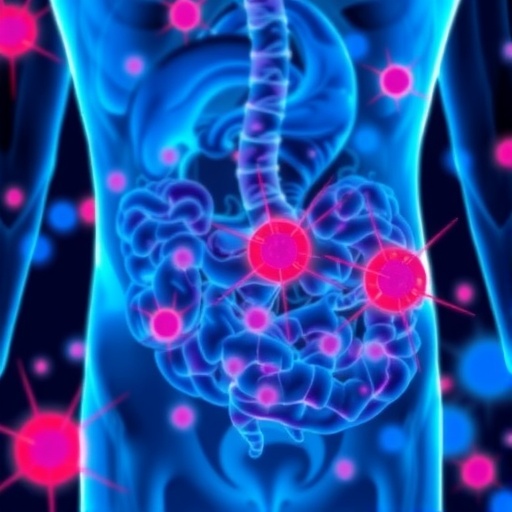A groundbreaking study conducted by researchers at The University of Osaka has unveiled critical insights into the pathogenesis of Crohn’s disease through the discovery of key transcription factors that orchestrate the behavior of tissue-resident memory T cells (T_RM) within the intestinal mucosa. Led by Drs. Mitsuru Arase, Mari Murakami, and Prof. Kiyoshi Takeda, this investigation illuminates how the transcription factors RUNX2 and BHLHE40 drive the differentiation and pathogenic activity of T_RM cells implicated in the chronic inflammation characteristic of Crohn’s disease. Published in the Journal of Experimental Medicine, this research paves the way for novel therapeutic strategies targeting these molecular regulators to mitigate disease relapse and inflammatory progression.
Crohn’s disease is notoriously difficult to manage due to its complex immune dysregulation and persistent inflammation localized to the gastrointestinal tract. At the crux of this chronic condition lies a specialized subset of T cells known as tissue-resident memory T cells (T_RM), which exhibit long-term residency within the intestinal mucosa. These cells differ markedly from circulating T cells and have been increasingly recognized for their role in sustaining localized immune responses. Yet, the precise molecular mechanisms governing their induction and maintenance in Crohn’s disease have remained elusive.
Utilizing a comprehensive single-cell multi-omic analysis approach, the Osaka team scrutinized gut T cell populations harvested from Crohn’s disease patients. This high-resolution technique enabled the dissection of complex transcriptional programs within individual T cells, unveiling a striking accumulation of T_RM cells expressing elevated levels of the transcription factors RUNX2 and BHLHE40. Notably, this study identified a disease-specific isoform of RUNX2 distinct from the variant previously characterized in osteoblast differentiation, suggesting a unique functional adaptation of RUNX2 within the immune milieu of the diseased gut.
To elucidate the functional roles of these transcription factors, the researchers conducted gain- and loss-of-function experiments using T cells derived from both healthy individuals and Crohn’s disease patients. Forced overexpression of RUNX2 and BHLHE40 in blood-derived T cells led to a significant upregulation of pro-inflammatory cytokine interferon-gamma (IFN-γ) and the cytotoxic effector molecule granzyme B (GZMB). Moreover, these modified T cells exhibited enhanced tissue retention properties, mirroring the pathogenic persistence of T_RM cells in inflamed intestinal tissue. Conversely, suppression of these factors in patient-derived gut T cells attenuated their inflammatory cytokine production and reduced their capacity to remain localized within the tissue, highlighting the pivotal role of RUNX2 and BHLHE40 in sustaining chronic inflammation.
Mechanistically, RUNX2 and BHLHE40 appear to orchestrate transcriptional programs that promote the stringency of T_RM residency and effector functions, thereby fueling the immune-mediated tissue damage observed in Crohn’s disease. RUNX2, traditionally acknowledged for its role in bone development, emerges here as a context-dependent regulator of immune cell differentiation, modulating gene networks that endow T_RM cells with both inflammatory potency and the ability to persist in the intestinal environment. In parallel, BHLHE40, known for its involvement in circadian and immune regulation, synergizes with RUNX2 to amplify these pathological attributes.
This research carries profound clinical implications. By pinpointing RUNX2 and BHLHE40 as master regulators of pathogenic T_RM cells, it opens new avenues for therapeutic intervention aimed at selectively modulating T cell function and tissue residency without broadly suppressing systemic immunity. Targeting these transcription factors may enable finely tuned immunomodulation that limits tissue inflammation and prevents disease flare-ups, a major hurdle in current Crohn’s disease management.
Furthermore, the discovery of a Crohn’s disease-specific variant of RUNX2 hints at the possible development of highly selective biomarkers for disease diagnosis and monitoring. Such molecular signatures could enhance early detection, disease stratification, and treatment personalization, ultimately improving patient outcomes.
Dr. Mari Murakami, the study’s lead author, expressed optimism regarding the impact of these findings: “By uncovering the transcriptional circuitry underpinning the induction of T cells that drive Crohn’s disease inflammation, our work lays the foundation for revolutionary diagnostic and therapeutic strategies. We are deeply grateful to the patients and collaborators who made this research possible.”
The methodology employed in this study, combining single-cell transcriptomics with functional genomics, exemplifies the power of multi-omics approaches to unravel the complexity of immune cell populations in human disease. Such detailed cellular and molecular analyses are indispensable for deciphering disease mechanisms at unprecedented resolution, facilitating the transition from descriptive pathology to mechanistic understanding and targeted therapy.
In sum, this research delineates a novel paradigm wherein RUNX2 and BHLHE40 not only mediate the differentiation of gut-resident memory CD4⁺ T cells but also instigate a persistent inflammatory cascade central to Crohn’s disease pathology. Given the refractory nature of Crohn’s disease and its substantial burden on patients, the identification of these transcription factors as key drivers heralds a potential shift towards precision immunotherapy aimed at durable disease remission.
As The University of Osaka continues to push the frontiers of biomedical innovation, this study highlights the institution’s commitment to translating cutting-edge science into tangible health benefits. With further investigation into RUNX2 and BHLHE40 signaling pathways, future research may unlock novel drug candidates or gene-editing strategies capable of reprogramming pathogenic T cells, offering hope for millions afflicted by Crohn’s disease worldwide.
Subject of Research: Cells
Article Title: Multi-omics uncovers transcriptional programs of gut-resident memory CD4⁺ T cells in Crohn’s Disease
News Publication Date: 4-Sep-2025
Web References: http://dx.doi.org/10.1084/jem.20242106
Image Credits: Mitsuru Arase and The University of Osaka
Keywords: Life sciences; Health and medicine; Gastroenterology; Medical specialties




